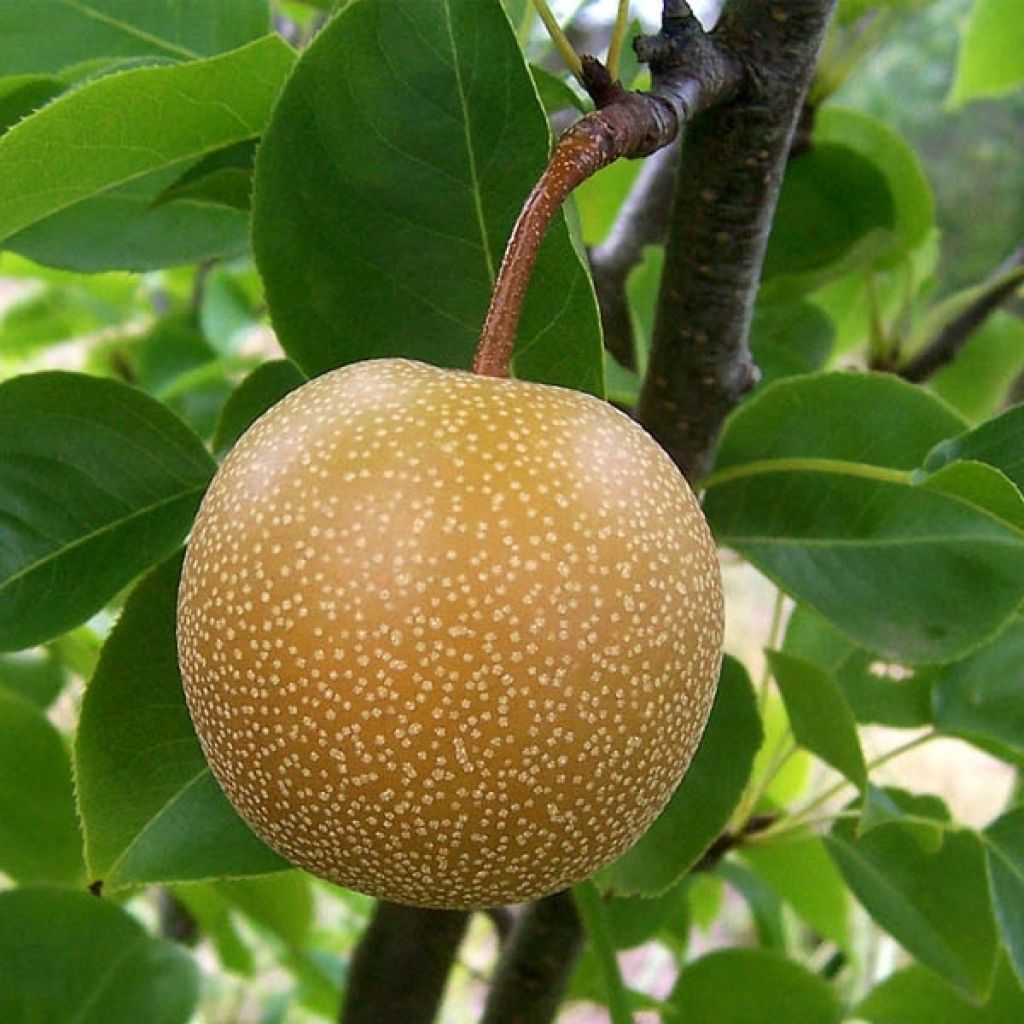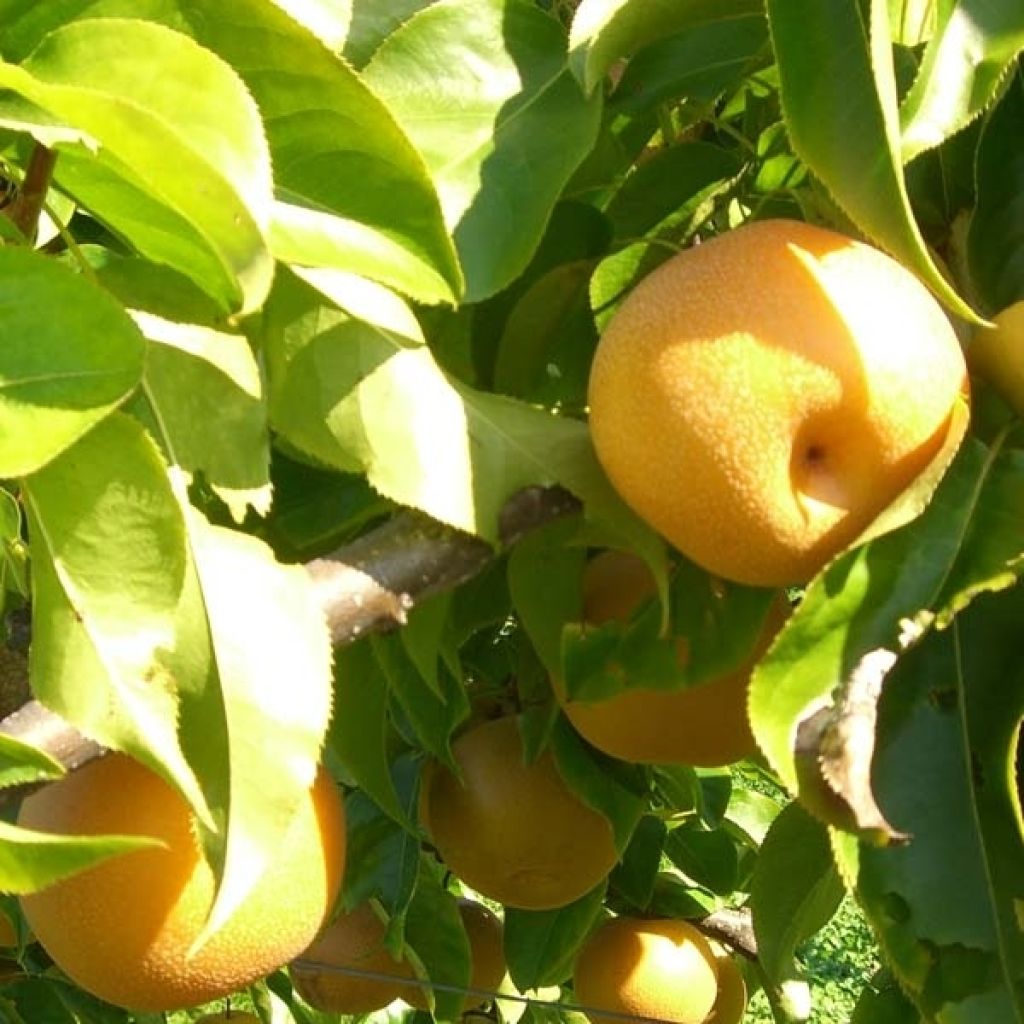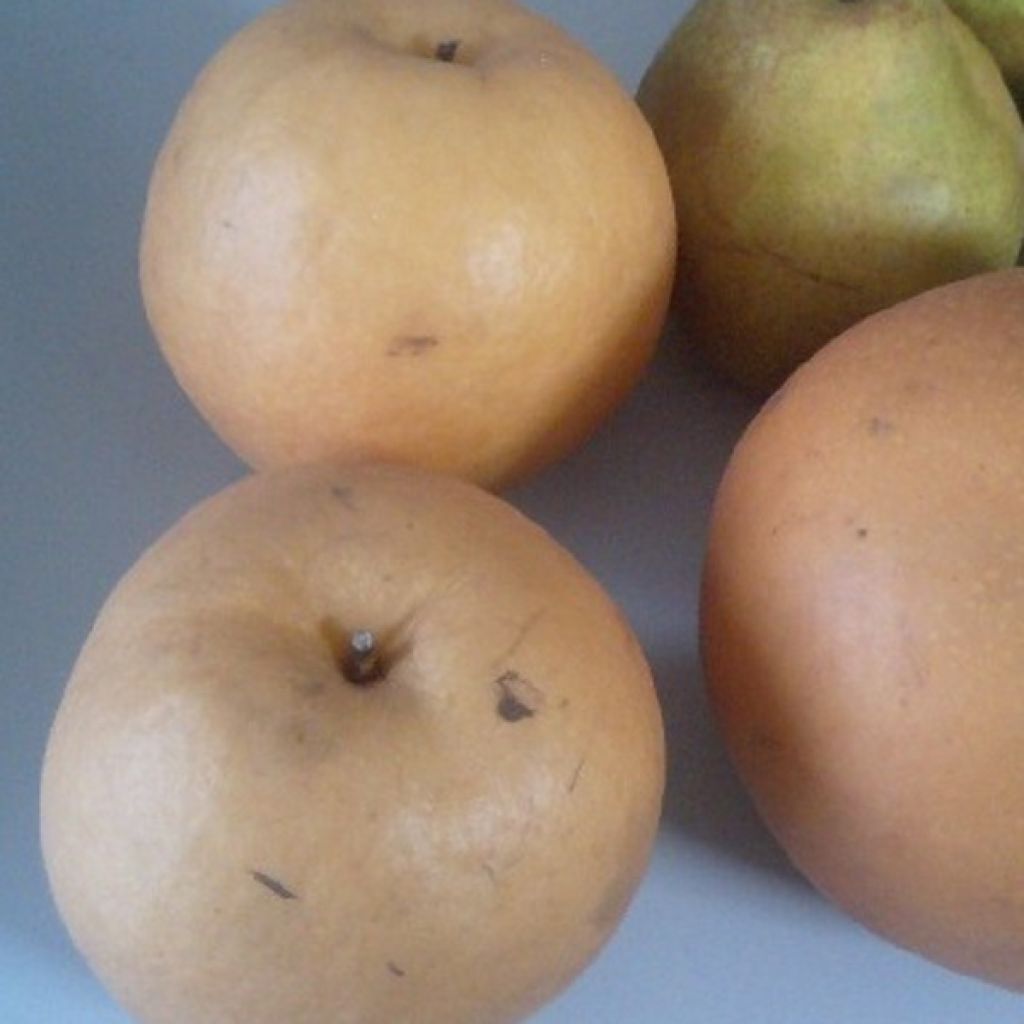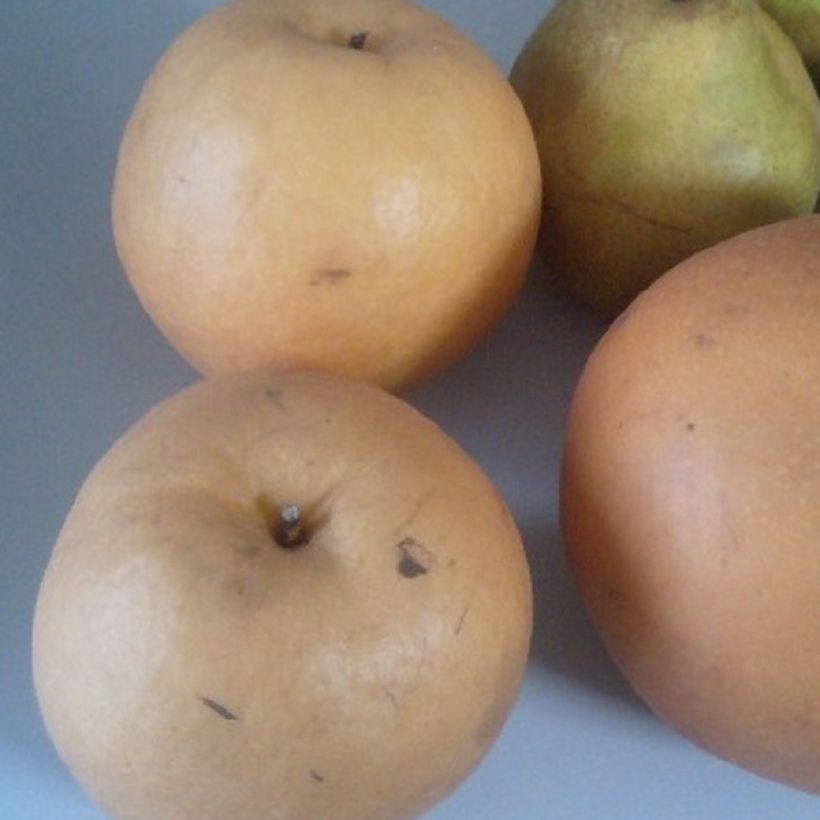

Nashi Shinseiki Bio en racines nues, forme scion


Nashi Shinseiki Bio en racines nues, forme scion


Nashi Shinseiki Bio en racines nues, forme scion
Nashi Shinseiki Organic - Apple-Pear
Pyrus pyrifolia Shinseiki
Asian Pear, Chinese Pear, Japanese Pear, Korean Pear, Sand Pear, Nashi Pear
This plant carries a 6 months recovery warranty
More information
We guarantee the quality of our plants for a full growing cycle, and will replace at our expense any plant that fails to recover under normal climatic and planting conditions.
Oversize package: home delivery by special carrier from €6.90 per order..
Express home delivery from €8.90.
Delivery to Corse prohibited: UE law prohibits the import of this plant from mainland France to Corse as part of the fight against Xylella fastidiosa. Please accept our sincere apologies.
More information

Description
The Organic Nashi 'Shinseiki', in Latin Pyrus pyrifolia, is a variety of Asian Pear, vigorous and productive, rather early, providing round fruits that are slightly flattened, of medium size, covered with a thick and smooth skin of yellow-green colour. Their white flesh is crunchy and juicy, of good taste quality. These exotic fruits are sometimes called "apple-pear" as they resemble apples in shape and pears in the juicy and slightly granular texture of their flesh. The Nashi is a hardy tree, both fruit-bearing and ornamental with its spring white-pink flowering. This variety is self-fertile, but fruit production will be improved in the presence of a 'Williams' pear, for example. Planting is preferably done in autumn, harvest starting from mid-August. Plants from Organic Agriculture.
Although the Nashi is not a cross between an apple tree and a pear tree, its fruits are sometimes called "apple-pear" as they resemble apples while having the texture of pears. Once peeled, nashis are consumed like apples and pears, mostly for sweet dishes (pies, compotes, crumbles, fruit salads, etc.) or sometimes as accompaniments to meats or cheeses. They keep well in the refrigerator, about 2 to 3 months.
'Shinseiki' is a Japanese variety, vigorous and productive. It is a self-fertile variety, whose production can be improved if there is a nearby 'William' pear. It is also a good pollinator. Flowering begins in late March, in the form of white-pink flowers with 5 petals. It is followed by fruit formation, which is harvested from mid-August. Harvest the fruits when they are ripe as they do not ripen further after harvest.
The Nashi (in Latin Pyrus pyrifolia) is a bush of the Rose family and the genus Pyrus, like the Pear tree. Cultivated for a long time in Asia, it has recently appeared in France. The term Nashi refers to both the bush and the fruit. The Nashi is a hardy bush, able to withstand up to -18°C (-0.4°F), with a slightly weeping habit. It will reach 4 to 5 metres (13 to 16 feet) in height at maturity and 2 to 3 metres (7 to 10 feet) in width. This fruit tree needs the winter cold to bear fruit. Its leaves are elongated, slightly larger than those of the Pear tree (10 cm (4in) long). They fall in autumn. Thanks to its beautiful spring flowering and autumn colors, the Asian Pear is also an ornamental tree. In the garden, it can be planted in the orchard, at the back of a border, or in isolation.
For transport reasons, our tallest scions may be pruned before shipping. They are suitable for all common pruning methods: cordons, espaliers, goblets, half-standards, and low standards, except for high standards. If you would like more information or advice on pruning your fruit trees, please do not hesitate to contact us.
Report an error about the product description
Nashi Shinseiki Organic - Apple-Pear in pictures


Plant habit
Fruit
Flowering
Foliage
Botanical data
Pyrus
pyrifolia
Shinseiki
Rosaceae
Asian Pear, Chinese Pear, Japanese Pear, Korean Pear, Sand Pear, Nashi Pear
Middle East
Planting and care
Planting can be done in frost-free autumn or winter, or in spring with regular watering. The Nashi thrives in all types of soil, whether neutral, acidic, or slightly chalky. It appreciates rich and well-drained soils. Choose a sunny and sheltered location.
Soak the root ball in water for a few moments before planting. Dig a hole about 3 to 4 times the volume of the root ball. Add well-rotted compost or potting soil, place the root ball, and cover with soil. Firmly tamp down and water generously.
During cultivation, water regularly, especially during hot weather. Mulch at the base to retain moisture in summer. In winter, you can add a small handful of wood ash, rich in potash, to improve fruiting.
Planting period
Intended location
Care
-
, onOrder confirmed
Reply from on Promesse de fleurs
Haven't found what you were looking for?
Hardiness is the lowest winter temperature a plant can endure without suffering serious damage or even dying. However, hardiness is affected by location (a sheltered area, such as a patio), protection (winter cover) and soil type (hardiness is improved by well-drained soil).

Photo Sharing Terms & Conditions
In order to encourage gardeners to interact and share their experiences, Promesse de fleurs offers various media enabling content to be uploaded onto its Site - in particular via the ‘Photo sharing’ module.
The User agrees to refrain from:
- Posting any content that is illegal, prejudicial, insulting, racist, inciteful to hatred, revisionist, contrary to public decency, that infringes on privacy or on the privacy rights of third parties, in particular the publicity rights of persons and goods, intellectual property rights, or the right to privacy.
- Submitting content on behalf of a third party;
- Impersonate the identity of a third party and/or publish any personal information about a third party;
In general, the User undertakes to refrain from any unethical behaviour.
All Content (in particular text, comments, files, images, photos, videos, creative works, etc.), which may be subject to property or intellectual property rights, image or other private rights, shall remain the property of the User, subject to the limited rights granted by the terms of the licence granted by Promesse de fleurs as stated below. Users are at liberty to publish or not to publish such Content on the Site, notably via the ‘Photo Sharing’ facility, and accept that this Content shall be made public and freely accessible, notably on the Internet.
Users further acknowledge, undertake to have ,and guarantee that they hold all necessary rights and permissions to publish such material on the Site, in particular with regard to the legislation in force pertaining to any privacy, property, intellectual property, image, or contractual rights, or rights of any other nature. By publishing such Content on the Site, Users acknowledge accepting full liability as publishers of the Content within the meaning of the law, and grant Promesse de fleurs, free of charge, an inclusive, worldwide licence for the said Content for the entire duration of its publication, including all reproduction, representation, up/downloading, displaying, performing, transmission, and storage rights.
Users also grant permission for their name to be linked to the Content and accept that this link may not always be made available.
By engaging in posting material, Users consent to their Content becoming automatically accessible on the Internet, in particular on other sites and/or blogs and/or web pages of the Promesse de fleurs site, including in particular social pages and the Promesse de fleurs catalogue.
Users may secure the removal of entrusted content free of charge by issuing a simple request via our contact form.
The flowering period indicated on our website applies to countries and regions located in USDA zone 8 (France, the United Kingdom, Ireland, the Netherlands, etc.)
It will vary according to where you live:
- In zones 9 to 10 (Italy, Spain, Greece, etc.), flowering will occur about 2 to 4 weeks earlier.
- In zones 6 to 7 (Germany, Poland, Slovenia, and lower mountainous regions), flowering will be delayed by 2 to 3 weeks.
- In zone 5 (Central Europe, Scandinavia), blooming will be delayed by 3 to 5 weeks.
In temperate climates, pruning of spring-flowering shrubs (forsythia, spireas, etc.) should be done just after flowering.
Pruning of summer-flowering shrubs (Indian Lilac, Perovskia, etc.) can be done in winter or spring.
In cold regions as well as with frost-sensitive plants, avoid pruning too early when severe frosts may still occur.
The planting period indicated on our website applies to countries and regions located in USDA zone 8 (France, United Kingdom, Ireland, Netherlands).
It will vary according to where you live:
- In Mediterranean zones (Marseille, Madrid, Milan, etc.), autumn and winter are the best planting periods.
- In continental zones (Strasbourg, Munich, Vienna, etc.), delay planting by 2 to 3 weeks in spring and bring it forward by 2 to 4 weeks in autumn.
- In mountainous regions (the Alps, Pyrenees, Carpathians, etc.), it is best to plant in late spring (May-June) or late summer (August-September).
The harvesting period indicated on our website applies to countries and regions in USDA zone 8 (France, England, Ireland, the Netherlands).
In colder areas (Scandinavia, Poland, Austria...) fruit and vegetable harvests are likely to be delayed by 3-4 weeks.
In warmer areas (Italy, Spain, Greece, etc.), harvesting will probably take place earlier, depending on weather conditions.
The sowing periods indicated on our website apply to countries and regions within USDA Zone 8 (France, UK, Ireland, Netherlands).
In colder areas (Scandinavia, Poland, Austria...), delay any outdoor sowing by 3-4 weeks, or sow under glass.
In warmer climes (Italy, Spain, Greece, etc.), bring outdoor sowing forward by a few weeks.

































